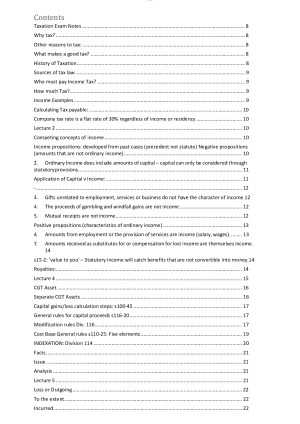Taxation Exam Notes
Subject notes for UNSW LAWS3751
Description
Contents Taxation Exam Notes 8 Why tax? 8 Other reasons to tax: 8 What makes a good tax? 8 History of Taxation 8 Sources of tax law 9 Who must pay Income Tax? 9 How much Tax? 9 Income Examples 9 Calculating Tax payable: 10 Company tax rate is a flat rate of 30% regardless of income or residency 10 Lecture 2 10 Competing concepts of income 10 Income propositions: developed from past cases (precedent not statute) Negative propositions (amounts that are not ordinary income) 10 2. Ordinary Income does include amounts of capital – capital can only be considered through statutory 11 - .................................................................................................................................................... 12 Application of Capital v Income: .................................................................................................. 11 3. Gifts unrelated to employment, services or business do not have the character of 4. The proceeds of gambling and windfall gains are not income 12 5. Mutual receipts are not income 12 Positive propositions (characteristics of ordinary income) 13 4. Amounts from employment or the provision of services are income (salary, wages). 13 7. Amounts received as substitutes for or compensation for lost income are themselves income. 14 s15-2: ‘value to you’ – Statutory income will catch benefits that are not convertible into Royalties: 14 Lecture 4 15 CGT Asset 16 Separate CGT Assets 16 Capital gains/loss calculation steps: s100-45 17 General rules for capital proceeds s116-20 17 Modification rules Div. 116 17 Cost Base General rules s110-25: Five elements 19 INDEXATION: Division 114 20 Facts 21 Issue 21 Analysis 21 Lecture 5 21 Loss or Outgoing 22 To the extent 22 Incurred 22 Necessarily Incurred 22 Nexus to income 22 Tests: 22 Negative Limbs of Deductions s 8-1(2) 24 Capital or capital nature: Structure v Process Test – Sun Newspapers case. 24 Private or domestic expenditure 25 Lecture 6 26 Lecture 6/7 28 UCA regime 28 Depreciating asset 28 Prime Cost Method 29 Diminishing Value 29 Lecture 7: Tax Accounting and Trading Stock 32 Which basis is appropriate? 32 Cash 32 Accruals 32 Changing methods from accruals to cash or vice versa 32 Derivation on a cash basis 32 Derivation on a cash basis 32 Incurring: accruals vs cash (expenses/ deductions) 33 What is trading stock? 33 When is trading stock on hand? 33 Valuation of trading stock 33 Lecture 8 - Partnerships 34 Joint property ownership 34 Tax treatment of partners 34 ITAA36 s90 calculation of net income or partnership loss 34 Individual Interest 34 When do partners derive income 35 Partner’s salaries 35 Trusts 35 Trustee: ITAA36 s6(1) definition: 36 Beneficiary: Not defined 36 Fundamentals of trust taxation: 36 Allocating Tax Between Trustee and Beneficiaries 36 Trust Income vs. Tax ‘Net’ Income 37 Anti-Splitting Provisions: 38 Taxation of Companies: 38 Public vs. Private Companies: 38 Significance of Public vs. Private: 38 Payment of Tax: 39 Carry Forward Losses: 39 Should Companies be taxed: 40 Dividend Imputation System: 40 Franking Accounts: Company Level 41 Maximum credit of distribution s202-60 = distribution amount x c/(1-c) 42 Franking Deficit Tax: 42 Shareholder Level 42 Example (Company): 43 International Tax 43 Dividend Example (Very Similar To Exam): 46 Capital Gains of Non-Residents: 48
UNSW
Term 3, 2020
48 pages
19,022 words
$49.00
2
Campus
UNSW, Kensington
Member since
September 2020
